Chili peppers, or how they are commonly known as, spicy peppers, are widely used in many cuisines and diets. Such ingredients add a touch of heat to any dish but too many of their nuances can actually be too much for your palate. So how to enjoy those spicy aromas without getting all red in your face or asking for too many glasses of milk?
Scoville heat unit or SHU is a simple measurement that indicates the amount of capsaicin present in the pepper or hot sauce. Let’s just say this – the higher the Scoville rating, the hotter the pepper.
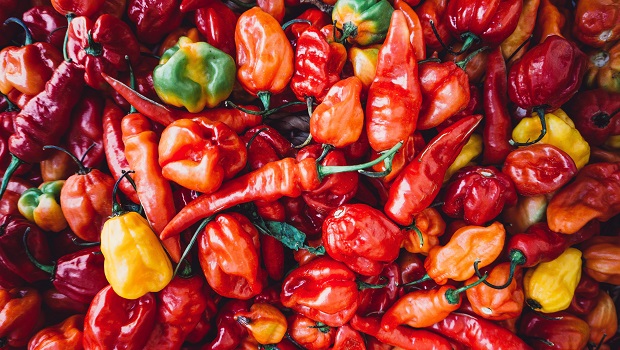

Now, we researched the field and made a round-up of the 20 most popular spicy peppers – ranked by the level of heat (so you can go with the ones that are suitable for your own spicy level).
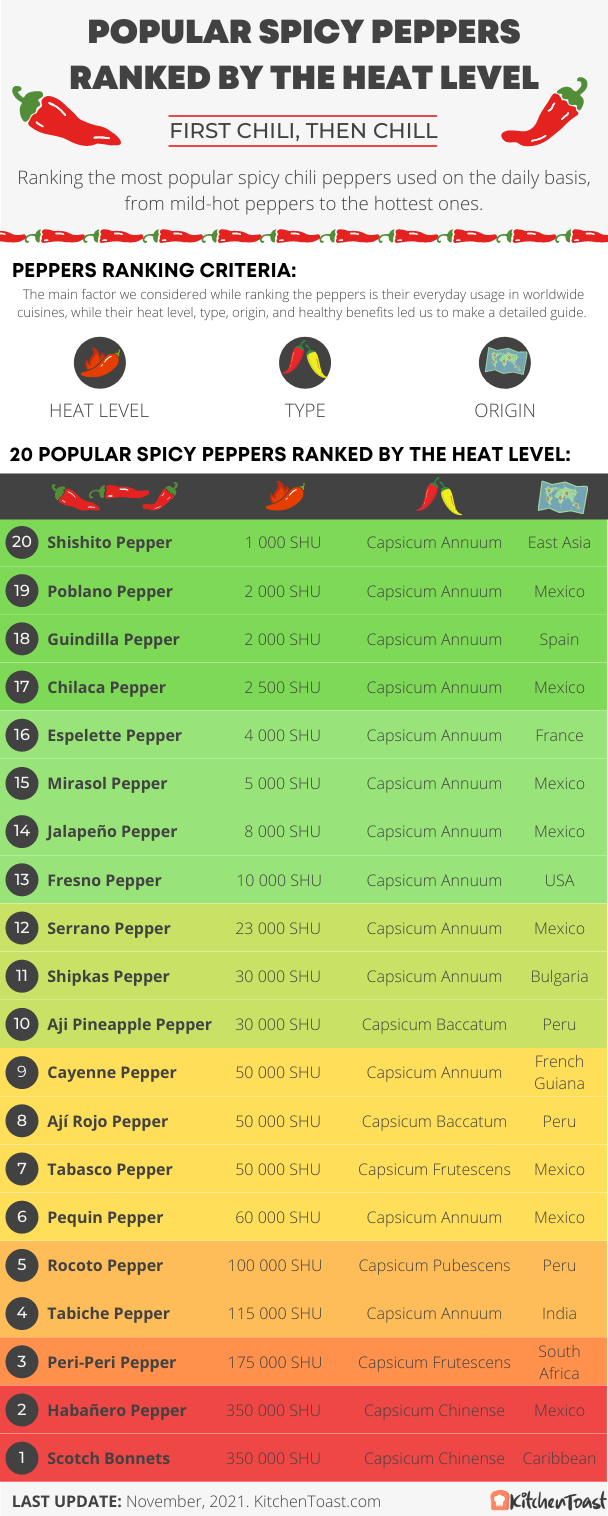

Why Are Peppers Hot?
Okay, so let’s start with this simple question – why are some peppers (too) mean? There are a couple of factors that determine the heat of the peppers.
The type of pepper is, of course, the first factor. It is important to know which particular strain you’re dealing with because then you’ll know whether that pepper has been bred with minimum or maximum heat.
Most of the spicy heat is located in the peppers’ seeds and fleshy internal ribs. So basically, if you remove those parts, you can lower the heat for a bit (but have in mind that this isn’t the rule that goes for ALL chili peppers).
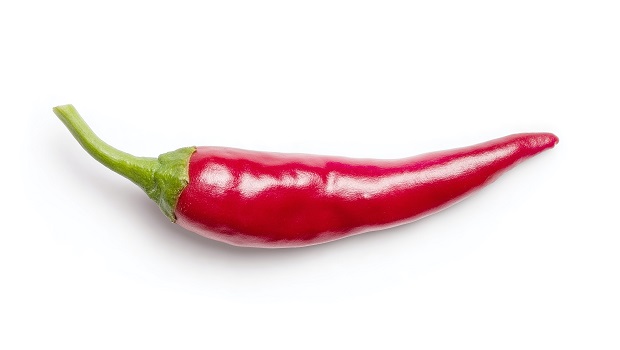

One more factor that indicates the hotness of the peppers is the time the pepper was harvested. The peppers that are harvested green will have less heat, while the ones that have begun to ripen to golden, orange, or red are hotter.
The capsaicin we already mentioned is a chemical in peppers that actually makes your mouth burn. When you place a pepper into your mouth, this chemical binds to receptors that respond to pain from the heat in your mouth and throat. This action triggers the brain which then sends a message to remove the hot substances to the body. All that results in increased circulation, sweat, runny nose, and teary eyes.
If They Are So Mean, Why Eat Them?
Chili peppers actually have great health benefits! They are rich in various vitamins and minerals – from vitamins A, C, B6, and K1 to potassium, and copper. So basically, your body gets a significant amount of micronutrients while consuming hot peppers.
Capsanthin, which is the main carotenoid in red chili peppers, is a powerful antioxidant, while lutein of the green chili peppers is linked to the improvement of eye health. The main bioactive plant compound in chili peppers, capsaicin, is a pain reliever. It also has anti-inflammatory benefits so it can help to prevent allergies and their symptoms.


Besides that, spicy peppers improve metabolism and they are great protectors which fight the flu, colds, and fungal infections. Eating hot pepper powder acts as a disinfectant and it improves the odor of your breath.
There are many more chili pepper benefits to your body and health, but we need to mention one more fact that is equally important – chili peppers are delicious if prepared in the right way and by suitable recipes.
Top 20 Spicy Peppers – Popular & Hot
There are many types of peppers and today, we want to focus on those that will give your palate and taste buds a meal to remember – tasty nuances with a spicy note. We researched the topic from head to toe in order to bring you the 20 most popular spicy peppers which are used (almost) on a daily basis and in the most delicious recipes. But before getting into the list, here are some of the interesting facts we came across while researching.
- There are more than 400 different chili peppers.
- Chili peppers are RICH in vitamin C.
- The second bite is hotter than the first one.
- Stuffy nose? Eat a pepper.
- The smaller the pepper, the hotter it is.
- November is National Pepper Month.
- The ribs can be up to 16x hotter than the rest of the pepper.
- The Carolina Reaper is the hottest pepper in the world with 2,2 million SHU.


These fun facts are a bit of a chill before chili. But are you ready for what’s coming? I’m sure you are. Let the countdown begin – from the mild-hot peppers to the hottest ones, here are the most popular chili peppers!
20. Shishito Pepper
- Heat Level Range: 100 to 1000 SHU
- Type: Capsicum Annuum
- Origin: East Asia
- Find It Here
The thin-skinned little green peppers are mild but be careful – every 10th shishito will make you red and sweaty.
19. Poblano Pepper
- Heat Level Range: 1 000 to 2 000 SHU
- Type: Capsicum Annuum
- Origin: Mexico
- Find It Here
This popular Mexican chili pepper comes in a very dark green color, it is mild, large, and heart-shaped.
18. Guindilla Pepper
- Heat Level Range: 1 000 to 2 000 SHU
- Type: Capsicum Annuum
- Origin: Spain
- Find It Here
Red guindilla peppers are narrow and long. They have medium-hot nuances and sweet flavor.
17. Chilaca Pepper
- Heat Level Range: 1 000 to 2 500 SHU
- Type: Capsicum Annuum
- Origin: Mexico
- Find It Here
With its dark green and curvy body, chilaca mildly hot pepper is a part of Mexican cuisine. Its heat level is often referred to as family friendly.
16. Espelette Pepper
- Heat Level Range: 400 to 4 000 SHU
- Type: Capsicum Annuum
- Origin: France
- Find It Here
Espelette peppers combine fruity and fresh nuances with mild hints of heat. The peppers are long and curvy.
15. Mirasol Pepper
- Heat Level Range: 2 500 to 5 000 SHU
- Type: Capsicum Annuum
- Origin: Mexico
- Find It Here
This popular Mexican chili pepper has a milder to mild-medium heat range and its nuances come with hints of strawberry and other berries.
14. Jalapeño Pepper
- Heat Level Range: 2 500 to 8 000 SHU
- Type: Capsicum Annuum
- Origin: Mexico
- Find It Here
Jalapeño pepper is one of the most well-known varieties of peppers. It is a medium-sized chili pepper and its heat range varies from moderate to hot.
13. Fresno Pepper
- Heat Level Range: 2 500 to 10 000 SHU
- Type: Capsicum Annuum
- Origin: United States of America
- Find It Here
Fresno pepper is a quite popular pepper in the culinary department thanks to its mild heat level with fruity, smoky hints.
12. Serrano Pepper
- Heat Level Range: 10 000 to 23 000 SHU
- Type: Capsicum Annuum
- Origin: Mexico
- Find It Here
This pepper can be red, orange, yellow, green, or brown in color, and its spicy hints are great for salsas, relishes, sauces, and garnishes.
11. Shipkas Pepper
- Heat Level Range: 5 000 to 30 000 SHU
- Type: Capsicum Annuum
- Origin: Bulgaria
- Find It Here
Shipkas peppers, also known as Bulgarian carrot peppers, are little chili peppers with bright orange color, long and narrow body, and intense hot nuances with fruity flavors.
10. Aji Pineapple Pepper
- Heat Level Range: 20 000 to 30 000 SHU
- Type: Capsicum Baccatum
- Origin: Peru
- Find It Here
This spicy yellow pepper is a quite rare one. It has moderate hotness with distinct pineapple nuances.
9. Cayenne Pepper
- Heat Level Range: 30 000 to 50 000 SHU
- Type: Capsicum Annuum
- Origin: French Guiana
- Find It Here
Cayenne peppers come with medium heat and neutral flavor, and they easily bring spiciness to any dish.
8. Ají Rojo Pepper
- Heat Level Range: 30 000 to 50 000 SHU
- Type: Capsicum Baccatum
- Origin: Peru
- Find It Here
These Peruvian peppers have exotic flavors with a nice dose of hotness and spiciness. The heat level depends on the mature stage – the hottest ones come in deep orange color.
7. Tabasco Pepper
- Heat Level Range: 30 000 to 50 000 SHU
- Type: Capsicum Frutescens
- Origin: Mexico
- Find It Here
The vibrant red pepper is a quite hot pepper used for the preparation of Tabasco sauce. Tabasco pepper is one of the most well-known peppers, along with jalapeño pepper.
6. Pequin Pepper
- Heat Level Range: 30 000 to 60 000 SHU
- Type: Capsicum Annuum
- Origin: Mexico
- Find It Here
Pequin peppers are tiny but they come with a serious heat level, as well as fruity, citrusy hints.
5. Rocoto Pepper
- Heat Level Range: 30 000 to 100 000 SHU
- Type: Capsicum Pubescens
- Origin: Peru
- Find It Here
Despite its similar look to classic bell peppers, don’t be fooled – this juicy pepper comes with extra hot nuances.
4. Tabiche Pepper
- Heat Level Range: 85 000 to 115 000 SHU
- Type: Capsicum Annuum
- Origin: India
- Find It Here
Tabiche peppers are extremely thin and wrinkled, they have a good amount of heat, and are perfect when used dried in sauces and seasonings.
3. Peri-Peri Pepper
- Heat Level Range: 50 000 to 175 000 SHU
- Type: Capsicum Frutescens
- Origin: South Africa
- Find It Here
Peri-Peri, known as the African Bird’s Eye Chilli, are small but hot peppers used for preparing a variety of hot sauces.
2. Habañero Pepper
- Heat Level Range: 100 000 to 350 000 SHU
- Type: Capsicum Chinense
- Origin: Mexico
- Find It Here
These hot peppers are considered to be one of the meanest peppers out there. They are hot and spicy with a hint of sweet, fruity nuances.
1. Scotch Bonnets
- Heat Level Range: 100 000 to 350 000 SHU
- Type: Capsicum Chinense
- Origin: Caribbean
- Find It Here
Scotch bonnets or Caribbean red peppers come with a flat and wide appearance, while their inner parts carry hotness and heat with hints of tomatoes, cherries, and apples.
Market Info
Besides ranking down the most popular hot peppers used in the culinary department these days, we also mentioned where to find these specific peppers.
Now, you have probably noticed that some links lead to the peppers and seeds, while others to some spice versions of them. The heat level may depend on the type of ingredient you buy, but if you want to buy fresh peppers without any spice versions, sauces, or seeds, here are a couple of more ideas where you can find them (including both shops and online sources).
- Vegetable Markets
- Specialty Farms
- Spice Markets
- Trader Joe’s
- Chile Plants
- Baker’s Peppers
- Bonica Pepper Hut
- A&M Farms
Hot Ideas
Besides mentioning all the beautiful hot pepper charms, we wanted to share some delicious and spicy inspiration that will seduce your palate and taste buds. And hotness, of course. Oh, and have in mind that hot peppers can be eaten raw, grilled, roasted, toasted, pan-seared, and stuffed, or used in the preparation of snacks, sauces, seasonings, and more. Quite versatile ingredients!
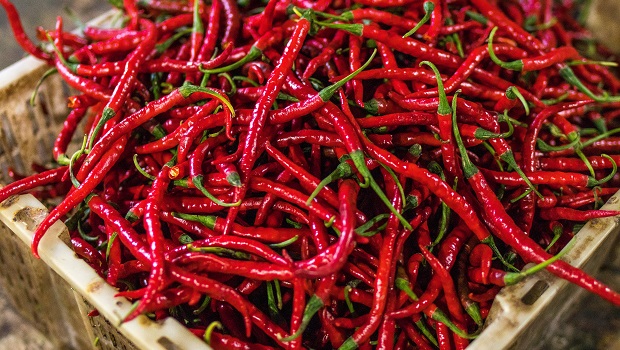

Now, here comes our top spicy picks on how to use hot peppers!
- Mexican Inspired Dishes – tortillas, tacos, chorizo, and enchiladas are just a couple of dishes that work perfectly in combination with spicy peppers.
- Stuffed Peppers – just like with any other type of bell pepper, hot peppers are suitable for stuffing too. You can make a mixture according to your preferences and use meat, cheese, breadcrumbs, vegetables, and more. Perfect on the inside, hot on the outside.
- Seasonal Soups – spicy pumpkin soup? Why not! Just add Fresno and jalapeño peppers, and you’re done.
- Sauces – hot peppers are perfect ingredients for homemade spicy sauces and you’re the boss who decides the heat level.
- Marinade – in case you love crispy and spicy chicken wings (or some other meat), hot peppers can easily be added to the marinade.
- Snacks – no, we don’t mean eating hot peppers as snacks but you can certainly add them to the mix. For example, you can roast pumpkin seeds sprinkled with cajun pepper seasoning. Or make homemade potato chips with some other hot seasoning.
- Fresh Appetizers – in case you really love eating fresh peppers, you can always serve them as appetizers with cold cuts and some interesting sauces, and toasted bread.
To Wrap It Up
Hot peppers are here to stay, you know it! And this article contains the list of 20 most popular spicy peppers, ranked by their level of hotness and heat. All the mentioned peppers are daily used in many cuisines, culinary departments, and restaurants. So they are quite popular in both professional and personal lives. From homemade recipes to chefs’ modern touches, spicy peppers are the most used hot ingredients.
Besides mentioning the peppers, we talked about what makes such ingredients hot, what are some fun and interesting facts about them, where to buy, how to use them, health benefits, and more. Quite a hot article, we must admit!
Now chill before chili!












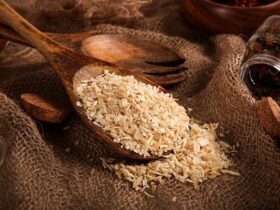

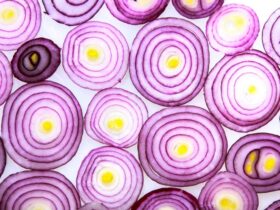

Leave a Reply